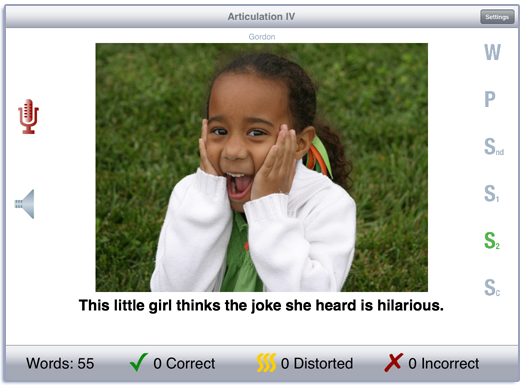
The Articulation IV app teaches receptive and expressive language skills while children practice their good speech.
This app has four of the most common articulation targets (R, S, L, and Th) in the Initial, Medial, Final positions and in Consonant Clusters.
New vocabulary includes words that are necessary for today's classroom success such as: compost, awesome, LOL, USB port, browser, search engine, etc.
Sort the words by target sound and position, and by curriculum area. Groups include: computer-related words, math, time and measurement, curriculum words, emotions, food, and music.
Target Audience Appropriate for ages 5–Adult for Articulation, Dialect Reduction, Apraxia, and Dysarthria.
Just $9.99 on the App Store.
See More Images
View the Wordlist
Information for Professionals
A clear speech model is presented for the child to imitate and they can record and play back their own speech. The clinician can choose from three scoring methods. 1. Score each response as correct, distorted or incorrect. 2. Score responses as correct, distorted, substituted, or omitted. 3. Score productions based on whether they are spontaneously correct/incorrect or imitatively correct/incorrect.
The artic-type apps can be used just for articulation therapy but the format lends itself to other applications as well.
Central Auditory Processing Disorder
Research indicates that phonemic processing is critical to auditory processing of connected speech. This software title allows for auditory processing of speech sounds at the phoneme level using the Sounds button. This slowing down and segmentation of the word allows the listener to process the phonemic units that make up the word, imitate the units, record their production, and play back their speech to self-monitor. Self-correction and self-monitoring are the first steps in automatic integrated auditory processing and accurate verbal expression.
Literacy Development and Dyslexia
This title is appropriate for children and adults learning to read or those with reading and spelling difficulty. Refer to the LocuTour Guide to Letters, Sounds, and Symbols for more information about spelling and pronunciation rules. If the client copies the word from the computer screen to a word list, they are also developing shifting attention skills, visual perceptual, and motor sequencing skills.
Auditory Memory and Working Memory
Requiring forward and backward repetition of the words, phrases and sentences can help those with short-term memory problems, sustained, and shifting attention difficulties. Use felts on the table to “anchor” the sounds in sequence. We have used this process of repetition to increase the amount of information a client can hold in working memory. The process of forward repetition can teach the compensatory strategy of “reauditorization”. If you can develop your “internal tape recorder” you have a second chance to replay and thus comprehend auditory information. Reverse repetition is usually not recommended.
Aphasia Therapy
The pictures can be used to stimulate conversational speech, check auditory comprehension, and to practice repetition, naming, writing, and reading skills. Use the record features to make your own cueing strategies. The software is designed to present a speech model at the sound, word, phrase, and sentence levels. The record feature will allow several minutes of recording but will not save the recording when you move to the next screen.
Right Hemisphere Syndrome
The treatment of Right Hemisphere dysfunction will include visual scanning, reading, writing, speech intonation, perception of affect, comprehension of humor, idioms, metaphors, and logic. The pictures can be used as a launching point for describing the details of visual images such as, color, size, shape, number, smell, taste, sound, perspective, movement, mood, and background. The main idea of the picture can be identified to assist with focusing on relevant stimuli and ignoring irrelevant details. As an extension activity, have the client tell what could happen next. The client will need to understand the gestalt of the picture story before being able to make their own extension sentences or infer meaning from the picture. Questions such as, “What was the dog doing?” and, “Why do you think he might be feeling that way?” encourage them to tell brief stories. These can be recorded using the recording feature and played back to allow some processing of their own speech. The therapist can track topic maintenance or appropriateness of responses.
Traumatic Brain Injury
The communication deficits related to TBI often include dysarthria, auditory and reading comprehension problems, anomia, and pragmatic language disorders. In a small group setting, the software can be used to present a stimuli and allow the individuals to practice turn taking, appropriate conversation, and topic maintenance. It is possible to use the recording features for feedback and self-monitoring on perseverative responses, inappropriate laughter, swearing, and off task responses. Use of the Alphabetical word order option can allow the therapist to present the same stimuli each day. As the client progresses, you can increase the variability for responses using the Random option. Repeating the word, phrase, and sentences forward and backward at a level in which your client is successful 85% of the time, will develop working memory, short-term memory skills, and mental flexibility.
Apraxia
Auditory feedback is critical for self-monitoring of dysarthric speech. The pictures were chosen for content, phonemic complexity, and “picturability”. The screen was designed to allow visual and/or auditory stimuli. An Apraxic client may prefer to have the words displayed and use the Word and Phrase buttons for self-paced imitative speech practice. Most clients can practice on their own or with an assistant. Use of the CDI button will allow the client to keep track of their perception of the accuracy of reproduction of the stimulus. The comparison of their perception of intelligibility and your perception of intelligibility can be insightful when planning therapy goals.
This app is based on the Word Practice game from LocuTour’s Artic Games & More! CD.
Rationale This task requires the ability to attend to a series of complex auditory stimuli, analyze the sound segments, and imitate these sounds in sequence. It requires auditory processing at the sound, syllable, phrase, and sentence levels with imitative or spontaneous expressive articulatory production.